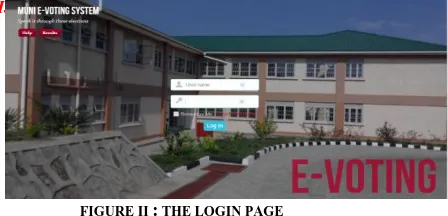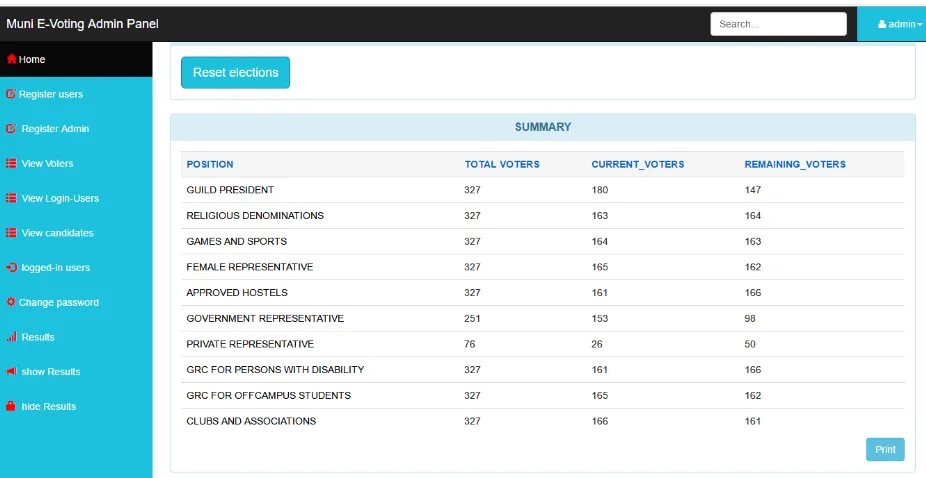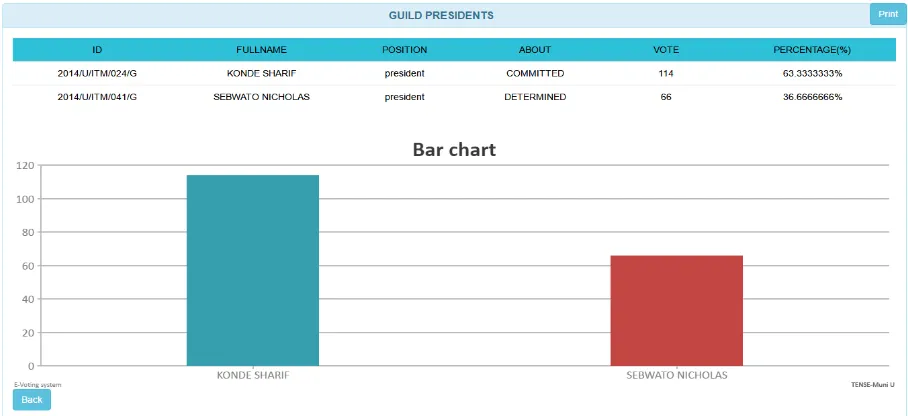Design and Implementation of Electronic
Voting System
Taban Habibu1, Konde Sharif 2, Sebwato Nicholas3
1, 2, 3
Department of Computer and Information Science, Muni University, Arua Uganda.
Abstract
The Public opinion and democratic in universities setting are the most important determinant to establish a good administration. Voting is the process through which individuals convey their opinion and has the freedom to elect a leader of the choice to signify and address the student’s issues. In today’s technological and knowledge age, computerized related matters become widespread. E-voting is one of these substances and it is capable to deliver appropriate, less costly, fast and secure services. The aim of this paper is to present an electronic voting system (E-Voting) to be applied to Muni University student’s electoral body. Several security measures were integrated into the E-Voting system in order to achieve an enhanced, speedy and accurate performance. A computer software application was developed using PHP (Hypertext processor) programming language and MYSQL (My Structural Query Language), a relational database management system in designing the database; tested and found to have produced the expected results. It is about time that traditional voting in Muni University gives way to E-Voting and hence simplifies the task for Electoral commission and his/her Officials.
Keywords
:
Muni University, Elections, E-Voting,Security.
I. INTRODUCTION
Muni University is a Public Campus established by the Uganda Government by Constitutional Instrument, 2013 No.31 [1]. The university is located in Arua district, 3Km South of Arua town in North-Western Uganda. Students at Muni University are required to have free and fair elections for a democratic of the student’s union. Elections allow the populace to choose their representatives to express their preferences for how they will be governed. Thus, the integrity and accuracy of the election process are fundamental to the integrity of the democracy itself. Today, many new technological innovations are developing the computerized security and fair exchange including electronic voting which is becoming a popular trend. Our University, Muni, is also trying to keep abreast with the other established Universities in every arena. Therefore, students from Muni start to replace electronic voting instead of traditional paper voting for saving university resources and time. The implementation of secure electronic voting systems is very critical in every student’s electoral body. The
main goal of e-Voting is to provide voters (students) a good environment so that students can cast their votes with minimum cost and efforts. There are so many properties that have been proposed to make the e-Voting secure process. The properties are: - Eligibility: Only eligible/registered students (voters) are permitted to cast and use the system. Secrecy: There is no association between student’s identification and the system. Exceptionalness: No student can cast his/her vote more than once. Freeness: A student does not gain any information (a receipt) which can be used to prove to a coercer that she/he voted in a certain way. Justice: No incomplete result is obtainable before the concluding result comes out. Confirmable: Students can verify that their votes were computed correctly. Uncoercibility: No student can prove what he voted for others to prevent bribery. Effectiveness: The calculations can be achieved within a realistic amount of period.
II. LITERATUREREVIEW
A. Electronic Voting
Electronic Voting (EV) comprises the use of a computer rather than the traditional use of ballot at polling centers or by postal mail [2]. It involves the method for a group such as a meeting an electorate to make a decision or express an opinion, usually following discussions, debates or election campaigns [3]. It incorporates various types of voting such as kiosks, the Internet, telephones, punch cards, and mark sense or optical scan ballots. India as world’s largest democracy with a community of 1.1 billion [4], developed electronic voting machines (EVM). Embraced and supported by voters for elections enable to solve problems associated with the traditional paper-based voting system. The Estonian experience in deploying Internet voting in the United States (U.S) and about 3.4 percent voters were able to use the remote e-voting in 2003 and by 2007 the remote e-voting elections proved secure despite worries about hacker attacks, identity fraud, and vote count manipulation [5].
E-voting system raises numerous questions linked directly to votes such as lawful, societal, practical, partisan, managerial and monetary concerns. Though, profiting from the affirmative aspects of E-Voting desires the operation of security measures in order to repair the lack of transparency and to reclaim the trust of constituencies and liable Authorities [6], [8] and [9].
B. The Importance of the E-Voting System
According to [10] the importance of e-voting are obvious; empowerment; it empowers members to have a voice in the leadership and direction of their organization. When allowed to vote in fair and open elections, members will feel a greater sense of value, ownership, and responsibility. Accessibility; With the surge of mobile devices, online voting is a convenient option for many members, allowing them to access ballots anytime, anywhere. Cost effectiveness; Elections are cost effective, especially when considering production costs of printing, postage, and mailing ballots. Security and confidentiality; A properly designed e-voting system will safeguard in place to assure the security of ballots and protection of voter identities. Transparency; e-elections, particularly those run by a third-party, eliminate the chance of election mismanagement or fraud. An audible trail helps increase voter confidence. Accuracy and expedience; since e-voting utilizes electronic ballots, there are no rejected, mismarked, or invalid votes and results are automatically calculated, eliminating the need for manual tabulation or dreaded recounts. Furthermore, [11] point that e-voting promises an increase in participation and offers voters more options of convenience to vote, encourages more voters to cast their votes remotely, and has great potential to stimulate higher voter turnout. Casting and counting votes are much faster and more accurate with e-voting systems, by default there are no invalid or unclear ballots and the automatic gathering and counting of ballots reduce the amount of time spent counting votes and delivering the results. In addition, [12] pointed that e-voting reduced logistical and administrative costs. The system will reduce the materials required for printing and distribute ballots, the personnel required to assist in voting stations reduces and greater accessibility for the old and disabled people increase and allows to accommodate them as they cast their votes comfortably at their own homes.
III. MATERIALSANDMETHODS
A. The System Database and Specifications
MySQL server was used to implement the back-end of the system. The access to the database server was made possible by a graphical interface (phpMyadmin). The database name was given voting.
TABLE I: THE CATEGORICAL TABLE ATTRIBUTES
Field Type Null Key Default Length
Cat_id int No PRIMARY none 20
Cat_name varchar No - none 20
Start_time varchar No - none 20
End_time varchar No - none 20
TABLE II: THE CANDIDATE TABLE ATTRIBUTES
Field Type Null Key Default Length
Cand_id Int No PRIMARY none 20
Fullname varchar No - none 20
Username varchar No - none 20
image varchar No - none 20
Position varchar No - none 20
About varchar No - none 20
Voter_id Text No Foreign Key none 20
Cat_id int No Foreign Key None 20
TABLE III: THE RESULT TABLE ATTRIBUTES
Field Type Null Key Default Length
Result_id Int No PRIMARY NONE 20
Cat_id Int No Foreign Key none 20
vote count Int No - none 20
percentage double No - none 20
Cand_id Int No Foreign Key none 20
TABLE IV: THE VOTER TABLE ATTRIBUTES
Field Type Null Key Default Length
voter_id Text No PRIMARY None 20
image varchar No - None 20
firstname varchar No - None 20
lastname varchar No - none 20
Sex varchar No - None 20
username varchar No - None 20
password varchar No - None 20
course varchar No - none 20
sponsor varchar No - none 20
Cat_id Int No Foreign None 20
B. The Users’ Interaction with the System
voters must send their personal data including voter name and voter ID to the electorate chairman in order to be checked for validity.
FIGURE I : THE SYSTEM ARCHITECTURE
The system architecture indicated the modules and flow of the system.
C. The Online Voting Module
The online voting module presents the login form for the students to sign in.
FIGURE II : THE LOGIN PAGE
D. The Online Election Creation Module
The online election creation module is where the admin (electorate chair) creates polls, register the posts and the candidate as well as the voter’s particulars such as student guild, student religious leaders, student class representative and specify the start and end periods of the voting.
FIGURE III : THE ELECTION CREATION MODULE
Besides the online creation module, there is a voting component that displayed all registered posts and the corresponding candidates on each post.
The voter cast the vote on a post he/she wish and the system automatically adds the casted votes into the database and restricts the voter to vote twice.
FIGURE IV : THE ADMIN PANEL FOR AVAILABLE POSTS
This page allows voters to select the candidate of their choices.
FIGURE V : USERS LOGIN FOR VOTE CASTING
The page indicated the users who logged in for the vote cast at a particular time.
FIGUR VI : THE VOTE CASTING PAGE
The summary number of voters cast from different posts.
E. The Results Module
The results module provide the voter with summary numbers of the voters who voted and those
FIGURE VII : THE CANDIDATE RESULTS
F. Conclusion
This paper described the types of electronic voting systems and essential security properties of electronic voting systems. It aimed to design and implement a real application for an electronic voting system for Muni University. It satisfied the important properties such as receipt-freeness, verifiability, authentication, and integrity, efficient and easy-to-use graphical interface, saves money, time requirement. Furthermore, the integrated system would avail the electorates the opportunity of casting their votes using the most convenient medium among the e-voting. The adoption of the integrated system increased the level of participation in the institution because of the ease of voting and its tendency to eliminate electoral fraud. We, therefore, recommend that the Muni University should put the E-Voting technology at practice to phase out the traditional voting system. More rudiments to be focused on biometric technology to capture the real identity of the voter and broaden the security requirements of non-repudiation.
REFERENCES
[1] Ugandan Universities & Other Tertiary Institutions Act
(2006) as amended report.
[2] Anderson, C. (2006). A Timeline of Electronic Voting in
the United States. Retrieved November 28, 2016, from http://www.indypendent.org/?p=608
[3] Bellis, M. (2007). the History of Voting Machines.
Retrieved November 9, 2016, from
http://inventors.about.com/library/weekly/aa111300b.htm l
[4] Das, A. (2015).Usability of the electronic voting system
in India and innovatory approach, International Journal of Applied Science and Engineering Research, 2015, 4(5), 633-642.
[5] Heiberg, S., Laud, P & Willemson, J. (2011). The
application of voting for Estonian parliamentary elections of 2011, In International Conference on E-Voting and Identity, 2011 (pp. 208-223), Springer Berlin Heidelberg.
[6] Watt, B. (2002) "Implementing Electronic Voting" A
report addressing the legal issues by the implementation of electronic voting, University of Essex.
[7] Mitrou, L., Gritzalis, D., Katsikas, S., Quirchmayr, G.
(2003) "Electronic Voting: Constitutional and Legal Requirements, and their Technical Implications" Secure Electronic Voting (Ed. Gritzalis, D.A.), pp. 43-60. Kluwer, Boston.
[8] Riera, A. Brown, P. (2003) “Bringing Confidence to
Electronic Voting” The Electronic Journal of e-Government Volume 1 Issue 1, pp 43-50, available online at www.ejeg.com
[9] Xenakis, A., and Macintosh. A., (2004) "Procedural
security in electronic voting" Proceedings of the 37th Hawaii International Conference on System Sciences (HICSS 37), January 2004.
[10] Kohno, T., Stubblefield, A., Rubin, A., and
Wallach, D, (2004).Analysis of an Electronic Voting System. pp. 1-23.
[11] Thakur, S., Olugbara, O., Millham, R., Wesso, H. &
Sharif, M. (2014).Transforming voting paradigm the shift from offline through online to mobile voting, In 2014 IEEE 6th International Conference on Adaptive Science & Technology (ICAST), 2014, (pp. 1-7). IEEE.
[12] Eilu, E & Baguma, R. (2012). Bridging the User
Experience Gap in Mobile Phone Voting in Developing Countries, Strengthening the Role of Information and Communication Technology in Development, 2012, 134.
[13] Cranor, L.F., and Cytron, R.K. (1996). Design and
Implementation of a Security-Conscious Electronic Polling System. Retrieved November 9, 2016, from http://www.acm.org/crossroads/ords2-4/voting.html
[14] Rizka, M & Ghounam, H. (2007). A Novel E-voting in
Egypt, International Journal of Computer Science and Network Security.Vol.No.11.pp 226-234.
[15] Manish, K., Suresh, T., Hanumanthappa, M. and
Evangelin, D. (2005). Secure Mobile Based Voting System. Retrieved November 25, 2016 from: HTTP:// www.iceg.net/2008/books/2/35_324_350.pdf
[16] Rossler, G. (2011).E-voting: A survey and Introduction.
Retrieved April 9, 2016, from
http://wiki.agoraciudadana.org/images/5/56/An%2BIntro duction%2Bto%2BElectronic%2BVoting%2BSchemes.p df
[17] Haydar, M. (2013). FingerPrint Base Electronic Voting
System. Retrieved May 24, 2017, from
https://www.researchgate.net/publication/268657819
[18] Atiya, P., Sobia, H., & Saoud, S. (2013). Scope and



